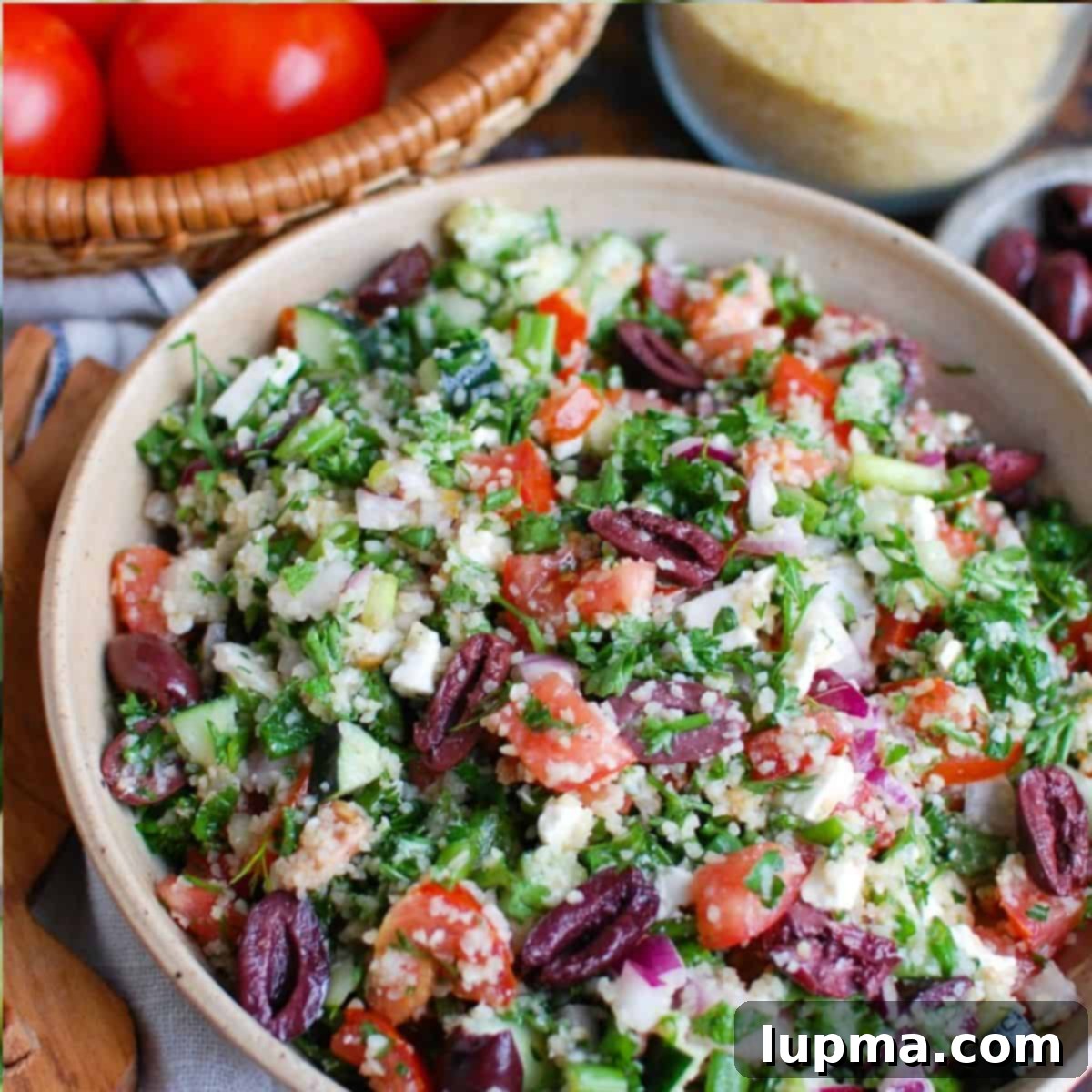Authentic Greek Tabbouleh: A Vibrant & Refreshing Mediterranean Salad
Embark on a culinary journey to the Mediterranean with this delightful Greek Tabbouleh recipe, a fresh and flavorful twist on the classic Middle Eastern salad. While traditional tabbouleh hails from Lebanon, this vibrant rendition infuses the beloved dish with the distinctive tastes of Greek cuisine, creating a light, healthy, and incredibly satisfying meal. We’re talking about the irresistible combination of briny Kalamata olives, creamy feta cheese, crisp red onion, and refreshing cucumber, all harmoniously blended with ripe tomatoes, fresh parsley, zesty green onions, and an assortment of aromatic herbs. A bright, lemony dressing ties all these incredible flavors together, making for an unforgettable salad experience that’s perfect for any occasion.
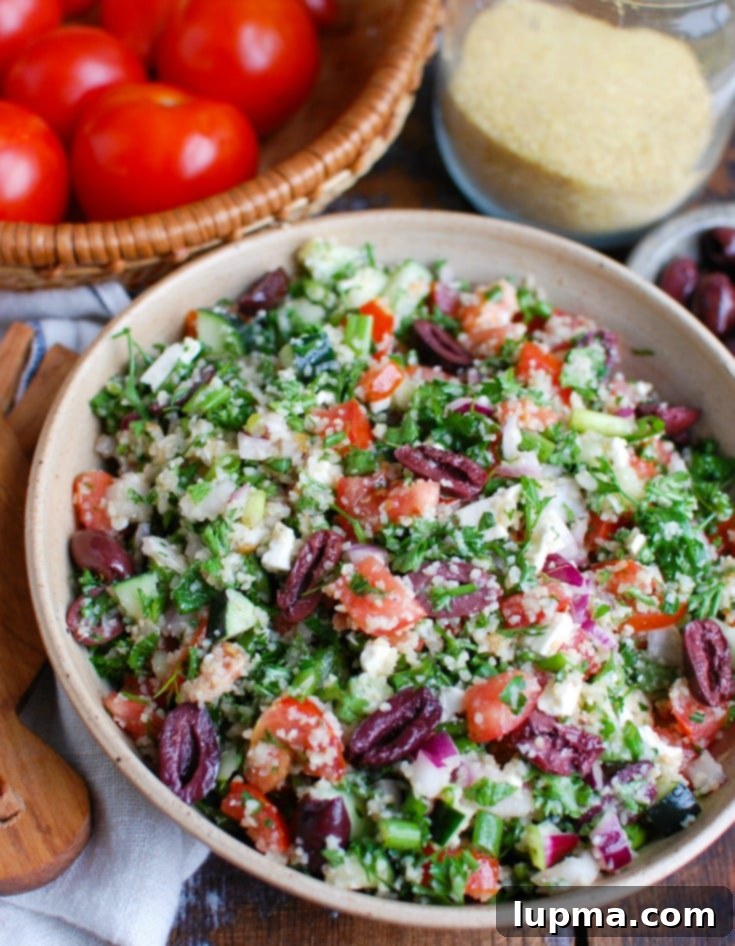
If you’re a fan of Mediterranean-inspired salads, especially those bursting with fresh ingredients and bold flavors, then you are definitely in for a treat! This Greek Tabbouleh takes everything you love about fresh, crisp salads and elevates it with a delicious Hellenic touch. It’s an ideal dish for a light lunch, a vibrant side to grilled meats, or a fantastic addition to any summer potluck.
My kitchen often smells of fresh herbs and lemon, especially during the warmer months, when I find myself making a batch of my Easy Tabbouleh Recipe almost weekly. There’s something truly special about utilizing fresh garden veggies or farmer’s market produce to create such a wholesome and delicious dish. However, the delightful appeal of tabbouleh isn’t limited by seasons. It’s a versatile salad that I enjoy preparing year-round, constantly exploring new variations to keep things exciting.
In the past, I’ve experimented with unique takes like Kale Cucumber Tabbouleh and Cauliflower Tabbouleh, both of which offer a fantastic alternative to the traditional version. For those new to the wonderful world of tabbouleh, let’s dive into what makes this Greek interpretation so special and how to create the perfect balance of flavors and textures.
What Makes Greek Tabbouleh Unique?
While classic tabbouleh typically features a higher ratio of parsley to bulgur wheat, along with tomatoes, mint, and a lemon-olive oil dressing, our Greek version introduces a delightful array of ingredients that instantly transport your taste buds to the sun-drenched shores of Greece. The addition of Kalamata olives, known for their distinct briny and fruity flavor, and creamy, salty feta cheese are the stars that truly differentiate this salad. These components add depth, richness, and a characteristic Greek profile that complements the traditional fresh vegetables and herbs beautifully. The crispness of cucumber and the sharpness of red onion further enhance the texture and taste, making each bite an invigorating experience.
Key Ingredients for Your Greek Tabbouleh
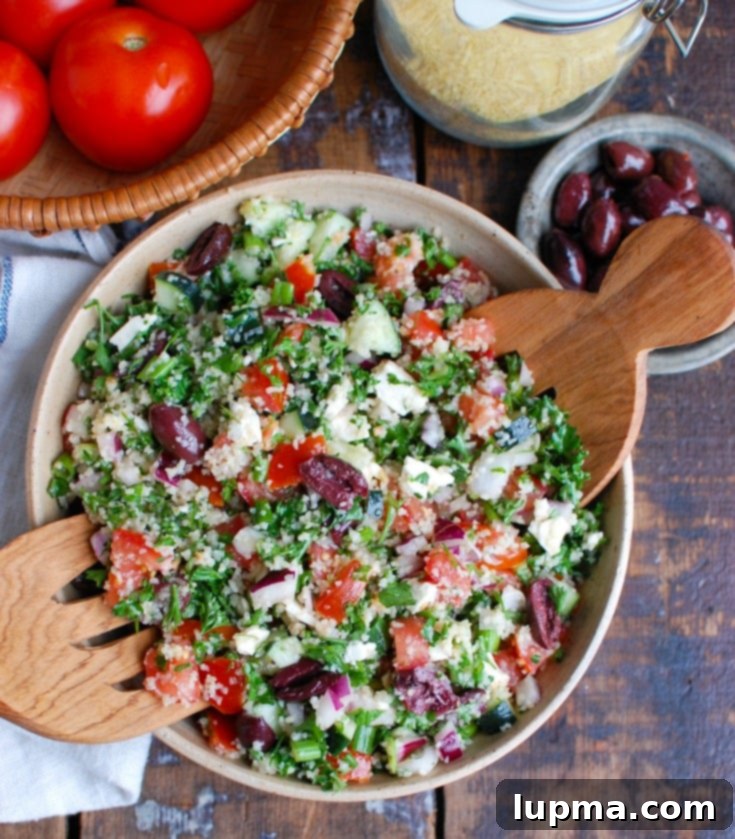
This recipe prides itself on using simple, fresh ingredients that are easy to find and come together to create an unforgettable marinade and salad. It’s truly one of my favorite go-to recipes for a healthy and delicious meal!
- Bulgur Wheat: This whole grain is the traditional base for tabbouleh. For this recipe, extra-fine bulgur is highly recommended because it requires minimal soaking, often just rinsing and a short rest, to achieve a soft, tender texture without cooking. If you opt for medium or coarse bulgur, be prepared to soak it in hot water for a longer period, typically around an hour, until it’s tender.
- Fresh Vegetables: The heart of any good salad lies in its vegetables. This Greek Tabbouleh features a vibrant medley of red onion for a pungent bite, ripe tomatoes for juicy sweetness, crisp cucumber for refreshing crunch, and green onions (scallions) for a mild onion flavor. Feel free to adjust quantities or swap out ingredients based on availability or personal preference.
- Kalamata Olives: A cornerstone of Greek cuisine, Kalamata olives bring a unique briny, savory, and slightly fruity flavor to the salad. They should be pitted and halved for easy eating. If you’re not a fan of olives, or if you prefer a milder taste, you can omit them, but they truly add an authentic Greek touch.
- Feta Cheese: Creamy, salty, and tangy feta cheese is another essential Greek ingredient. For the best flavor and texture, I strongly recommend using freshly crumbled feta from a block rather than pre-crumbled varieties, which can sometimes be drier and less flavorful.
- Fresh Herbs: A generous amount of fresh herbs is non-negotiable for an authentic and aromatic tabbouleh. This recipe calls for a blend of fresh mint, parsley, and dill. These herbs contribute incredible freshness and a complex aromatic profile. While dried herbs can be used in a pinch, fresh herbs will always deliver superior flavor and texture.
- Lemony Dressing: The dressing is a light yet flavorful concoction that perfectly complements the salad’s ingredients. It combines high-quality extra virgin olive oil, tangy red wine vinegar, and fresh lemon juice. A dash of salt and pepper rounds out the flavors, creating a dressing that is both bright and balanced.
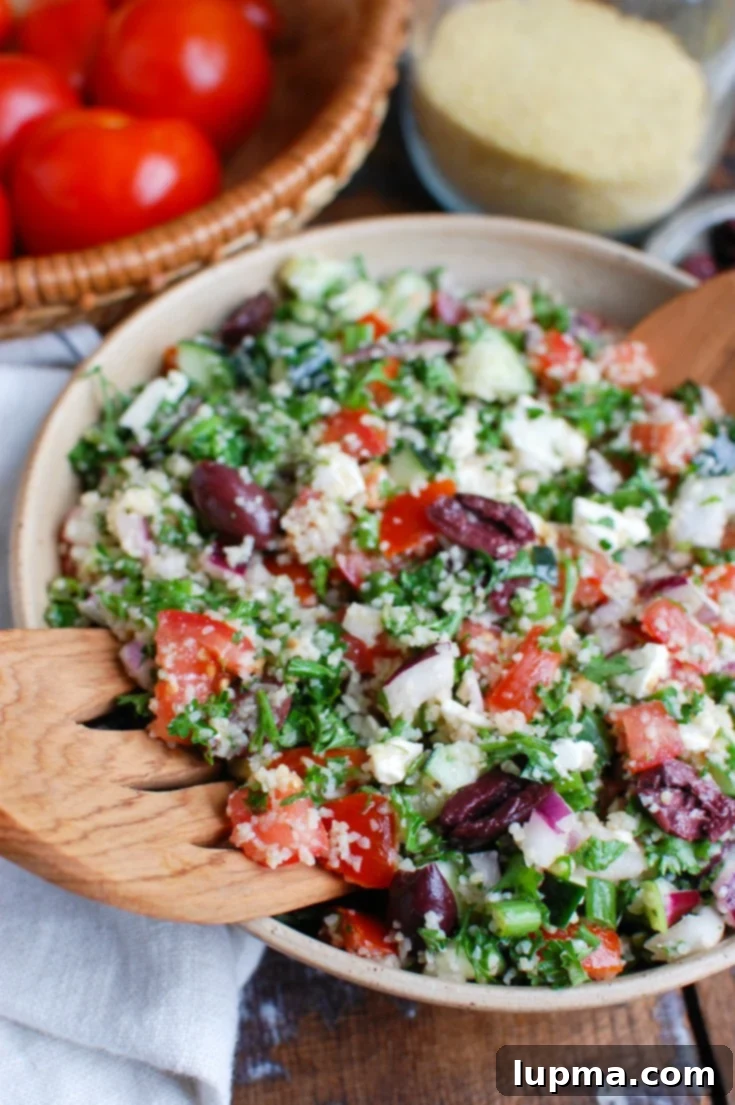
Creative Ways to Customize Your Greek Tabbouleh:
This Greek Tabbouleh recipe is incredibly versatile, allowing for numerous modifications to suit your taste preferences or whatever ingredients you have on hand. Don’t hesitate to get creative and make it your own!
- Add More Vegetables: Enhance the nutritional value and texture by incorporating extra vegetables. Bell peppers (red, yellow, or orange) add sweetness and crunch, while radishes provide a peppery bite. Celery offers a refreshing crispness, sun-dried tomatoes intensify the savory notes, and shredded carrots add a hint of sweetness and color. Consider zucchini or even artichoke hearts for an additional Mediterranean touch.
- Experiment with Herbs: While parsley, mint, and dill are fundamental to this recipe, don’t shy away from other fresh herbs. Cilantro can add a vibrant, zesty flavor, oregano will deepen the Greek profile, and fresh basil contributes a sweet, aromatic note.
- Boost with Beans: For added protein and fiber, beans are an excellent choice. Chickpeas (garbanzo beans) are a classic Mediterranean addition, offering a hearty texture. White beans, such as cannellini or great northern beans, also work beautifully, lending a creamy element to the salad.
- Cheese Varieties: While feta is king in Greek cuisine, other cheeses can offer interesting variations. Tangy goat cheese provides a different kind of creaminess, while fresh mozzarella balls (ciliegine or bocconcini) can add a milder, milky flavor. Shaved Parmesan could also be an adventurous addition.
- Include Nuts and Seeds: Introduce a delightful crunch and healthy fats by adding nuts or seeds. Toasted sesame seeds, sunflower seeds, sliced almonds, pine nuts, walnuts, or cashews are all fantastic options that add texture and nutritional benefits. Lightly toast them beforehand to bring out their full flavor.
- Add Protein for a Complete Meal: To transform this vibrant side dish into a fulfilling main course, incorporate a source of protein. Options include grilled shrimp, tender rotisserie chicken, freshly grilled chicken breast, flakes of canned tuna or salmon, thinly sliced steak, or even marinated and grilled tofu for a vegetarian option. Lentils are another great plant-based protein addition.
- Incorporate Greens: While tabbouleh is primarily a grain and herb salad, adding leafy greens can bulk it up and enhance its freshness. Baby spinach was a good choice, but fresh arugula offers a peppery kick that contrasts wonderfully with the other ingredients. Chopped romaine lettuce could also add a refreshing crispness.
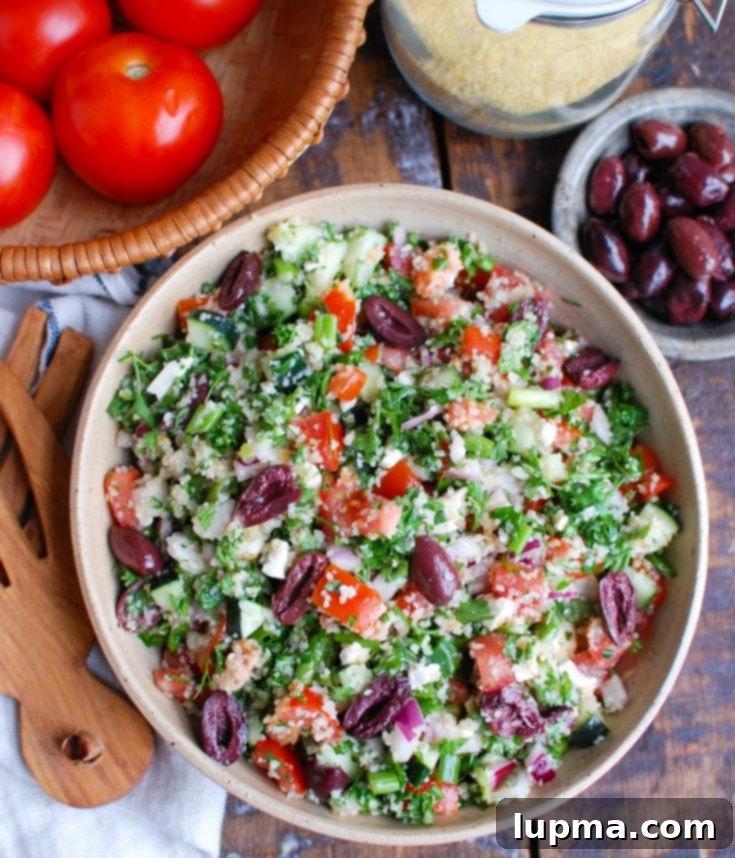
How to Make Greek Tabbouleh: A Simple Guide
Making this Greek Tabbouleh is straightforward and doesn’t require any complex cooking techniques. The key is in the preparation of the bulgur and the fine chopping of your fresh ingredients.
- Prepare the Bulgur Wheat: Begin by rinsing the extra-fine bulgur wheat thoroughly in a small bowl under cold water. Gently squeeze the bulgur in your hand to remove excess water, then transfer it to a new, clean dish. Repeat this rinsing and squeezing process two more times. This helps to clean the bulgur and starts the softening process. Once rinsed, cover the bulgur and refrigerate it for at least one hour. This allows it to fully hydrate and soften without becoming mushy. If using a coarser bulgur, soak it in hot water (not boiling) for about an hour, then drain well.
- Chop the Vegetables and Herbs: While the bulgur is chilling, prepare your fresh ingredients. In a large mixing bowl, combine the finely chopped red onion, diced Roma tomatoes, finely chopped fresh parsley, diced English cucumber, and chopped green onions (using both the green and white parts). Add the pitted and halved Kalamata olives, crumbled feta cheese, and finely chopped fresh dill and mint. Ensure all vegetables and herbs are chopped to a consistent, fine size for the best texture and flavor distribution.
- Prepare the Dressing: In a mason jar or a small salad dressing container, combine the extra virgin olive oil, fresh lemon juice, red wine vinegar, and a generous pinch of salt and pepper. Secure the lid and shake vigorously until all ingredients are well combined and emulsified. Alternatively, you can whisk the ingredients together in a small bowl until smooth.
- Combine and Toss: Once the bulgur is soft and ready, add it to the large bowl with the chopped vegetables and herbs. Gently toss all the ingredients together to ensure an even distribution.
- Dress and Serve: Pour the prepared lemony dressing over the tabbouleh mixture. Toss again gently until everything is well coated. If you have time, refrigerate the salad for at least 30 minutes before serving. This allows the flavors to meld and deepen, resulting in a more harmonious taste. Otherwise, it can be served immediately.
Why You’ll Adore This Greek Tabbouleh
This Greek Tabbouleh isn’t just a meal; it’s an experience. Here’s why it’s destined to become a staple in your kitchen:
- Exceptionally Healthy: Packed with fresh vegetables, whole grains (bulgur), and healthy fats from olive oil and feta, this salad aligns perfectly with the renowned Mediterranean diet. It’s rich in vitamins, minerals, and fiber, contributing to a well-balanced diet.
- Incredibly Refreshing: The vibrant combination of crisp vegetables, cooling herbs, and a zesty lemon dressing makes this salad unbelievably refreshing. It’s particularly invigorating on warm days but equally enjoyable year-round when you crave something light and bright.
- Remarkably Versatile: Whether served as a delightful side dish, a vibrant starter, or a light main course (especially with added protein), this tabbouleh fits seamlessly into any meal plan. It’s also fantastic as part of a larger mezze platter.
- Effortlessly Easy: With minimal cooking required (just soaking the bulgur) and simple chopping, this recipe is perfect for busy weeknights or for those who prefer quick and easy meal preparation.
- Excellent for Meal Prep: This salad holds up beautifully in the refrigerator, making it an ideal candidate for meal prepping. The flavors tend to develop even further as it sits, ensuring delicious leftovers for days.
Storage Tips for Optimal Freshness
Proper storage ensures your Greek Tabbouleh remains fresh and delicious for days. Store any leftovers in an airtight container in the refrigerator for 3-4 days. You might notice some excess liquid accumulating at the bottom; this is normal. Before serving, simply drain any excess liquid and freshen up the salad with an extra drizzle of good quality olive oil and a squeeze of fresh lemon juice. A sprinkle of fresh herbs can also revive its vibrant aroma and taste.
Frequently Asked Questions About Greek Tabbouleh
For tabbouleh, I highly recommend using extra-fine bulgur wheat. Its delicate texture means it doesn’t require cooking; a simple rinse and soak is enough to soften it perfectly, usually within an hour in the refrigerator. This results in a light, fluffy consistency that is characteristic of a great tabbouleh. If you opt for a coarser grade of bulgur (medium or coarse), you’ll need to soak it in hot (not boiling) water for approximately one hour or until it reaches your desired tenderness. Always drain it very well after soaking to prevent a watery salad.
Tabbouleh is delicious served either cold or at room temperature. It really comes down to personal preference. I grew up enjoying tabbouleh at room temperature, and it’s wonderful as the flavors are often more pronounced. However, on a hot day, a chilled tabbouleh can be incredibly refreshing. The important thing is to allow the salad to rest for at least 30 minutes after dressing to allow the flavors to meld.
Yes, finely chopping the parsley and other vegetables is crucial for achieving the ideal texture and flavor distribution in tabbouleh. A fine chop helps the parsley maintain a light, fluffy consistency and ensures that each bite contains a harmonious blend of all ingredients. Use a very sharp knife to finely dice everything without bruising the delicate herbs and vegetables, which can make them mushy. The goal is small, uniform pieces that are distinct yet blend well together.
Tried this recipe? Leave a star rating and comment below! Subscribe to my newsletter or follow me on
Facebook,
Instagram, or
Pinterest for the latest.
★
★
★
★
Greek Tabbouleh
Julia Jolliff
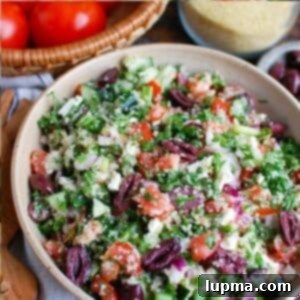
20 mins
20 mins
6
Ingredients
- 1/2 cup bulgur wheat, extra fine
- 1/3 cup red onion, chopped
- 5-6 Roma Tomatoes, diced
- 2 cups parsley, finely chopped
- 1/2 English cucumber, diced
- 6-7 green onions, green and white parts chopped
- 3/4 cup kalamata olives, pitted, halved
- 3 ounces feta cheese, crumbled
- 1/4 cup mint, finely chopped
- 2 Tablespoons dill, chopped
- 1/4 cup extra virgin olive oil
- 2 Tablespoons red wine vinegar
- 1/4 cup lemon juice
- Salt and pepper to taste
Instructions
- Rinse the bulgur wheat in a small bowl in cold water. Squeeze the bulgur in your hand to remove excess water and transfer to a new dish. Repeat this process two more times for thorough rinsing.
- Cover the rinsed bulgur wheat and refrigerate for one hour to allow it to soften and hydrate.
- In a large bowl, combine the finely chopped red onion, diced Roma tomatoes, finely chopped parsley, diced English cucumber, chopped green onions (both green and white parts), pitted and halved Kalamata olives, crumbled feta cheese, and finely chopped dill and mint.
- In a mason jar or salad dressing container, whisk or shake together the extra virgin olive oil, fresh lemon juice, red wine vinegar, salt, and pepper until well combined.
- Add the softened bulgur wheat to the bowl of chopped vegetables and herbs. Gently toss to combine all ingredients evenly.
- Pour the prepared dressing over the tabbouleh and toss again until everything is well coated. Refrigerate for at least 30 minutes if you have time, allowing the flavors to meld. Otherwise, serve immediately and enjoy!
Notes
- Tabbouleh also works great with other grains, including quinoa and sorghum, if you prefer an alternative to bulgur.
- For added protein, consider incorporating grilled chicken, grilled shrimp, or plant-based options like chickpeas (garbanzo beans) or white beans, transforming this salad into a hearty main course.
Nutrition
Carbohydrates: 17g,
Protein: 5g,
Fat: 15g,
Saturated Fat: 4g,
Polyunsaturated Fat: 1g,
Monounsaturated Fat: 9g,
Cholesterol: 13mg,
Sodium: 445mg,
Potassium: 404mg,
Fiber: 5g,
Sugar: 3g,
Vitamin A: 2479IU,
Vitamin C: 42mg,
Calcium: 136mg,
Iron: 2mg
Nutrition information is automatically calculated, so should only be used as an approximation.
Tried this recipe?
Mention @acedarspoon or tag #acedarspoon!
